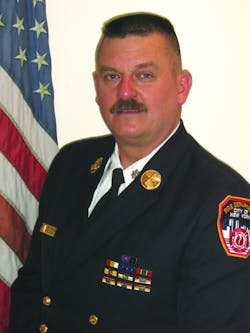The Fire Scene: Surviving a House Fire: Response & Operational Factors
If you look at and believe the statistics, operating at a house fire is one of the most frequent and dangerous events a firefighter can respond to. More firefighters and civilians are injured and killed at these operations than at any other type of fire.
Now that we know they are so dangerous, what else should we know about combating these dangerous fires? Let’s take a look at house fires and what we should be doing when we respond and operate at them.
The most important tactic at a house fire is the rapid and effective stretching of an attack hoseline. Yes, we all know there are lots of jobs that must get done, but none outweigh the stretching and operating of a hoseline. Nearly all residential fires call for the use of the 1¾-inch hoseline. Many engines carry both 1¾-inch and 2½-inch attack lines, but the smaller line is the best choice (the only choice, really) for a house fire. We use the small line so we can stretch and advance it more rapidly and easily than a larger line. In addition, it will deliver the 175 to 225 gpm that support an interior hoseline attack. These smaller hoselines also can be advanced through doorways and between and around the furniture typically found in private dwellings.
When stretching the attack hoseline to a house fire, the point of entry should be the front door. I know there are some fire service people out there recently suggesting that other, more scientific and study-based entry points should be considered, but I’m not one of them.
The reason we stretch the first hoseline to the front door is based on the structural design of private homes. It has nothing to do with that being the door that occupants will be escaping from, because they may not even use the front door of their home. It has everything to do with how the house is laid out – the room geometry. When you enter the front door of a private house, you generally will be at a central point where every other area of the home can be accessed. In particular, if it is a two-story house, you will be at, near or within sight of the stairway to the second floor. This fact is quite important and one of the major reasons we come in the front door.
Once we pass that stairway to advance to a fire elsewhere in the house, we own that piece of real estate and now firefighters can access the second floor, knowing the hoseline is between them and the fire. If you enter any other doorway and begin a fire attack, you can push fire, heat and smoke into the house where it can find its way up the stairway to the second floor. Studies are wonderful, but safety is better. Use the front door!
So we have our four-length, pre-connected hoseline pulled and flaked out on the front lawn. The fire is venting out two windows on the first-floor rear and heavy smoke is issuing from every other window in the house. The officer and the nozzle team are geared up, on air and ready to go at the front door. When does the officer call for water? Right now, even before entering the house, or at some other point after entry when conditions dictate? Answer: Right now!
Don’t enter a house fire with a dry hoseline. There are several good reasons for this important rule. First, you could encounter rapidly changing/deteriorating conditions and that’s not fun with a dry hoseline. Even if you quickly call for water it is TOO LATE! The second reason we don’t enter a house fire with a dry hoseline is that although we can pull the hoseline in fairly easily when it is dry, it is also flat. A flat hoseline looks innocent until it slides under an interior door. Once the line is there, the door will slow or stop the advance of the line. But that’s not all. If we call for water and the hose is still under the door, we now have a door that has stopped water from reaching the nozzle and a hoseline that has locked or chocked the door solidly wherever it is. This situation could leave a nozzle team unable to back out because of the immovable door and unable to fight the fire with no water.
The two issues discussed here are really basic. They are basic, but they are vital. Vital to your safety and survival and vital to the effective operations of your engine company. Knowing not only what to do, but also why, can make this difficult job we all do much easier, safer and more effective. Start a line.
